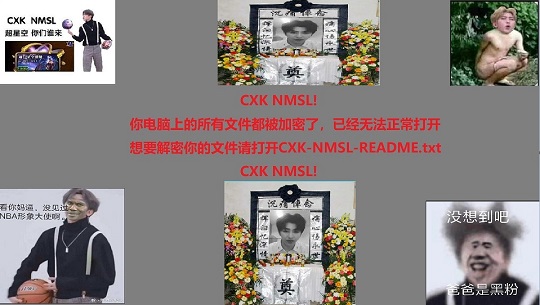Ransom.Win32.CAI.A
Trojan-Ransom.Win32.Encoder.hfk (KASPERSKY); Trojan-Ransom.CXK-NMSL (IKARUS)
Windows


Threat Type: Ransomware
Destructiveness: No
Encrypted:
In the wild: Yes
OVERVIEW
This Ransomware drops files as ransom note.
TECHNICAL DETAILS
Installation
This Ransomware drops the following files:
- %User Temp%\E_N60005\krnln.fnr = module to be loaded
- %User Temp%\abc.txt = not used
- %Application Data%\CXK-NMSL\CXK-NMSL.bat = encrypt files
- %Application Data%\CXK-NMSL\fuze.bat = starts CXK-NMSL.bat
- %Application Data%\Wallpaper.jpg = wallpaper to change
- %User Temp%\drawerror.exe = error icon mouse trail
- %Application Data%\message.vbs = start up msg box and opens browser and redirects to https://www.bilibili.com/video/av61335515/
- %User Temp%\╝ª─π╠½├└.mp3 = music to play
It adds the following processes:
- %Application Data%\CXK-NMSL\fuze.bat
- %Application Data%\CXK-NMSL\CXK-NMSL.bat
(Note: %Application Data% is the current user's Application Data folder, which is usually C:\Documents and Settings\{user name}\Application Data on Windows 2000(32-bit), XP, and Server 2003(32-bit), or C:\Users\{user name}\AppData\Roaming on Windows Vista, 7, 8, 8.1, 2008(64-bit), 2012(64-bit) and 10(64-bit).)
It creates the following folders:
- %User Temp%\E_N60005
- %Application Data%\CXK-NMSL
(Note: %User Temp% is the current user's Temp folder, which is usually C:\Documents and Settings\{user name}\Local Settings\Temp on Windows 2000(32-bit), XP, and Server 2003(32-bit), or C:\Users\{user name}\AppData\Local\Temp on Windows Vista, 7, 8, 8.1, 2008(64-bit), 2012(64-bit) and 10(64-bit).. %Application Data% is the current user's Application Data folder, which is usually C:\Documents and Settings\{user name}\Application Data on Windows 2000(32-bit), XP, and Server 2003(32-bit), or C:\Users\{user name}\AppData\Roaming on Windows Vista, 7, 8, 8.1, 2008(64-bit), 2012(64-bit) and 10(64-bit).)
Autostart Technique
This Ransomware adds the following registry entries to enable its automatic execution at every system startup:
HKEY_LOCAL_MACHINE\SOFTWARE\Microsoft\
Windows\CurrentVersion\Run
CXK = %Application Data%\message.vbs
Other System Modifications
This Ransomware modifies the following registry entries:
HKEY_CURRENT_USER\Software\Microsoft\
Internet Explorer\Main
Start Page = https://www.{BLOCKED}li.com/video/av61335515/ >
HKEY_CURRENT_USER\Software\Microsoft\
Internet Explorer\Main
Default_Page_URL = https://www.{BLOCKED}li.com/video/av61335515/
It changes the desktop wallpaper by modifying the following registry entries:
HKEY_CURRENT_USER\control panel\desktop
Wallpaper = %Application Data%\Wallpaper.jpg
It sets the system's desktop wallpaper to the following image:
Other Details
This Ransomware displays the following message boxes:





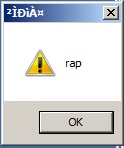
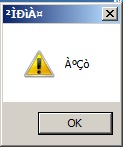
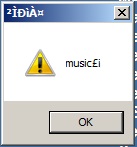
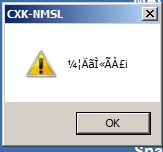

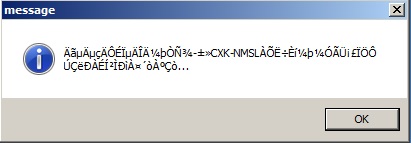
It does the following:
- Plays the mp3 file ╝ª─π╠½├└.mp3
- Opens internet explorer and redirects to https://www.{BLOCKED}li.com/video/av61335515/
- Displays an error trail that follow the user's cursor for 10 ms
- Deletes CXK-NMSL.bat after execution
- The ransomware appends .cxkdata to all the files in the following directories:
- %System Root%
- %User Profile%
- %User Profile%\Desktop\
- %User Profile%\Downloads\
- %User Profile%\Favorites\
- %User Profile%\Searches\
- %User Profile%\Saved Games\
- %User Profile%\Contacts\
- %User Profile%\Links\
- %User Profile%\Videos\
- %User Profile%\Pictures\
- %User Profile%\Documents\
- %User Profile%\Music\
- Then encodes them in Base64
- Successful : changes .cxkdata to cxk_msl
- Not successful : deletes the file
Ransomware Routine
This Ransomware drops the following file(s) as ransom note:
- {all directories and sub directories under %User Profile%}\CXK-NMSL-README.txt

SOLUTION
Step 1
Trend Micro Predictive Machine Learning detects and blocks malware at the first sign of its existence, before it executes on your system. When enabled, your Trend Micro product detects this malware under the following machine learning name:
- Troj.Win32.TRX.XXPE50FFF034
Step 2
Before doing any scans, Windows 7, Windows 8, Windows 8.1, and Windows 10 users must disable System Restore to allow full scanning of their computers.
Step 3
Note that not all files, folders, and registry keys and entries are installed on your computer during this malware's/spyware's/grayware's execution. This may be due to incomplete installation or other operating system conditions. If you do not find the same files/folders/registry information, please proceed to the next step.
Step 4
Search and delete this file
- %User Temp%\E_N60005\krnln.fnr
- %User Temp%\abc.txt
- %Application Data%\CXK-NMSL\CXK-NMSL.bat
- %Application Data%\CXK-NMSL\fuze.bat
- %Application Data%\Wallpaper.jpg
- %User Temp%\drawerror.exe
- %Application Data%\message.vbs
- %User Temp%\╝ª─π╠½├└.mp3
- {all directories and sub directories under %User Profile%}\CXK-NMSL-README.txt
Step 5
Search and delete these folders
- %User Temp%\E_N60005
- %Application Data%\CXK-NMSL
Step 6
Restore this modified registry value
Important: Editing the Windows Registry incorrectly can lead to irreversible system malfunction. Please do this step only if you know how or you can ask assistance from your system administrator. Else, check this Microsoft article first before modifying your computer's registry.
- In HKEY_CURRENT_USER\Software\Microsoft\Internet Explorer\Main
- Start Page = https://www.bilibili.com/video/av61335515/
- Start Page = https://www.bilibili.com/video/av61335515/
Step 7
Delete this registry value
Important: Editing the Windows Registry incorrectly can lead to irreversible system malfunction. Please do this step only if you know how or you can ask assistance from your system administrator. Else, check this Microsoft article first before modifying your computer's registry.
- In HKEY_CURRENT_USER\Software\Microsoft\Internet Explorer\Main
- Default_Page_URL = https://www.bilibili.com/video/av61335515/
- Default_Page_URL = https://www.bilibili.com/video/av61335515/
- In HKEY_LOCAL_MACHINE\SOFTWARE\Microsoft\Windows\CurrentVersion\Run
- CXK = %Application Data%\message.vbs
- CXK = %Application Data%\message.vbs
Step 8
Scan your computer with your Trend Micro product to delete files detected as Ransom.Win32.CAI.A. If the detected files have already been cleaned, deleted, or quarantined by your Trend Micro product, no further step is required. You may opt to simply delete the quarantined files. Please check the following Trend Micro Support pages for more information:
Step 9
Reset your Desktop properties
Step 10
Restore encrypted files from backup.
Did this description help? Tell us how we did.


